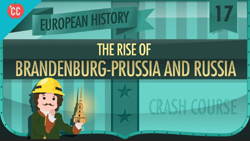| Absolute monarchs reigned in several European nations
during the Seventeenth Century. Louis XIV, considered the best example
of absolute monarchy, ruled France with an extravagant lifestyle and waged
many military campaigns. Meanwhile, Prussia, Austria, and Russia
emerged as great European powers under their monarchs’ leadership.
France Under Louis XIV
-
Louis XIV was an absolute monarch whose rule was admired
and imitated throughout Europe.
Absolutism is a system in which a ruler
holds total power.
One of the best examples of an absolutist monarch was
Louis
XIV, who fostered the idea of himself as the “Sun King,”
France’s source of light.
Richelieu and Mazarin
Cardinal Richelieu, as Louis XIII’s chief minister,
strengthened the monarch's power.
Because the Hugeunots were seen as a threat to the king,
Richelieu took away their political and military rights. He preserved,
however, the Protestants' religious rights.
Louis Comes to Power
Government and Religion
The royal court at Versailles was used by Louis
XIV as his personal household, as the center for state offices, and as
a place to have powerful subjects visit to seek favors.
Louis XIV sought religious unity by trying to convert
the Huguenots to Catholicism.
The Economy and War
Jean-Baptiste Colbert was Louis XIV’s controller-general
of France’s finances. To increase France's wealth and power, he followed
the principles of mercantilism.
To decrease imports, Colbert raised tariffs on foreign
goods.
Legacy of Louis XIV
When he died in 1715, Louis XIV, the Sun King, left France
deep in debt and surrounded by enemies.
REVIEW & DO
NOW
Answer the following questions in your spiral notebooks: |
What is absolutism?
The reign of which king was regarded as the best example
of absolutism?
What was the nickname of Louis XIV?
What number is XIV? |
Who was Cardinal Richelieu?
Whom did he see as a threat to King Louis XIII?
What rights of theirs did he take away?
What rights did he preserve?
When did Louis XIV die? |
|
|
Absolutism in Central and Eastern Europe
-
Prussia and Austria emerged as great European powers in the
Seventeenth and Eighteenth Centuries.
After the Thirty Years' War, the Holy Roman Empire was broken
into over three hundred individual German states.
Of all the German states, Prussia and Austria emerged
in the seventeenth and eighteenth centuries as great European powers.
The Emergence of Prussia
Frederick William the Great Elector
The Commissariat established by Frederick William in Prussia
became both a military and civil agency.
Many officials of the Commisasariat were Junkers,
or members of the Prussian landed aristocracy.
The New Austrian Empire
The Hapsburgs had lost their Holy Roman Empire in Germany,
but the Austrian Empire remained a collection of territories held together
by the loyalties of those states and their rulers to the Hapsburg emperor.
After the defeat of the Turks at Vienna in 1683, Austria
took control of Hungary, Croatia, Transylvania, and Slavonia.
Still, the Hapsburgs never never established a centralized,
absolutist state.
REVIEW & DO
NOW
Answer the following questions in your spiral notebooks: |
| How many German states were there after the Thirty Years’
War?
Which two German states emerged in the 17th and 18th Centuries
as great European powers? |
Who were the Junkers?
When and under what circumstances did the Austrians take
control of Hungary, Croatia, Transylvania, and Slavonia? |
|
|
Peter the Great
-
Russia emerged as a great power under Peter the Great.
In the Sixteenth Century, Ivan IV became the first
Russian ruler to take the title of czar.
Czar is the Russian word for Caeser.
Ivan IV expanded the territories of Russia eastward and
crushed the power of the boyars.
The boyars were the members of the Russian
nobility.
The Romanov dynasty began in 1613 in Russia when Michael
Romanov was chosen by the zemsky sabor, the national assembly,
to be the new czar.
Peter the Great
6' 8" tall
Became czar in 1689
an absolutist monarch who claimed divine right to rule
Peter the Great wanted to westernize, or Europeanize,
Russia
The Romanov dynasty lasted until World War I.
Cultural Changes and a New Capital
In 1703, Peter began the construction of a city on the
Baltic Sea. He intended the city of St. Petersburg to be the base
for his new Russian navy.
Military and Governmental Changes
Peter formed the first Russian navy and reorganized the
Russian military.
REVIEW & DO
NOW
Answer the following questions in your spiral notebooks: |
Who was the first Russian ruler to take the title of
czar?
—When did he do this?
—What does ‘czar’ mean? |
Who was chosen as the Russian czar in 1613?
—How long did his dynasty last?
Who was Peter the Great?
—What city did he establish? |
|
|
|







